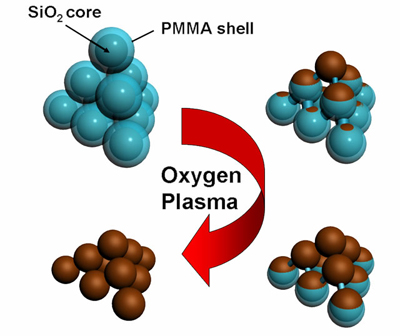Oxygen Plasma Etching Induced Crystalline Lattice Transformation of Colloidal Photonic Crystals
Photonic crystals (PCs)showed their potentials for their ability to control light. Close-packing monodisperse submicrometer spheres into three dimensional periodic structures, namely Bottom-Up assembly approach has been an important techniques to fabricate 3D PCs, due to their priority of easy-operation, low-cost and scalability. In most of the cases, the artificial 3D PCs obtained predominantly have face-centered cubic (fcc) crystalline structure which is energetically favorable. Theoretical calculation has suggested that only a pseudo photonic band gap exists in fcc lattice no matter how high the refractive index contrast is, which is caused by the symmetry induced degeneracy of photonic bands. And in its inversed optical structures, namely inverse opals, the refractive index contrast should be no lower than 2.8 to realize complete photonic band gap (CPBG). This demand means that there is no proper material to realize CPBG in visible region at the current stage.
To lower down the demand and make CPBG in visible region realizable with current available materials,under the long-term supports of the National Natural Science Foundation of China, the Chinese Ministry of Science and Technology, the Chinese Academy of Sciences, and Institute of Chemistry, Dr. SONG Kai’s group in the Key Laboratory of Photochemistry of Chinese Academy of Sciences started their research on the fabrication of 3D colloidal PCs with new symmetries and made a series of progresses since 2008. With external applied magnetic field to control the orientation of magnetic ellipsoidal colloids, they successfully fabricated 3D colloidal PCs of ellipsoidal building blocks and measured band gaps (Adv. Mater. 2009, 21, 1936-1940). On the basis of this work, they subsequently fabricated 3D PCs of ellipsoids with tunable orientations (Langmuir 2010, 26, 11544-11549). They also fabricated 3D PCs of oblate spheroids by blown film extrusion of prefabricated colloidal crystals (Langmuir 2009, 25, 10218-10222).
Recently, they reported the transformation of colloidal crystalline lattice which was realized via oxygen plasma etching of the colloidal crystals made of SiO2@PMMA core-shell microspheres. The plasma etching of the colloidal crystals proceeded nonuniformly from the top to the bottom of the colloidal crystals. The PMMA shell was etched away by oxygen plasma in a layer-by-layer manner and the silica core was drawn into the pit formed by the neighboring spheres in the layer below. Consequently, the crystalline lattice was transformed while maintaining the order. Colloidal crystals with simple cubic (sc) and body-centered cubic (bcc) lattice can be fabricated if the ratio between polymer shell thickness and silica core diameter equals to certain values. And these non-close-packed colloidal crystals also show prominent broader band gap compared with fcc colloidal PCs. This work was published on J. Am. Chem. Soc. 2010, 132, 17340-17342 and subsequently highlighted by Nature China (http://www.nature.com/nchina/2011/110105/full/nchina.2011.143.html).

Schematic illustration of the transformation of the crystalline lattice from fcc to sc induced by oxygen plasma etching. (Image by SONG Kai)





